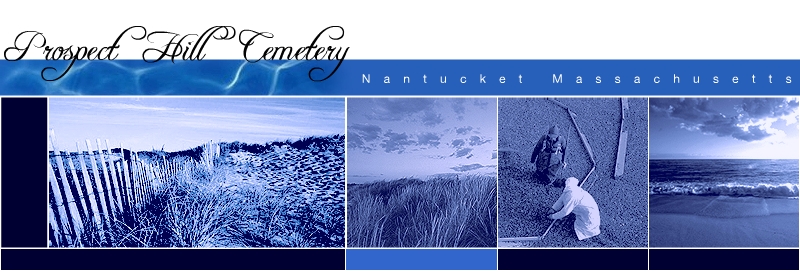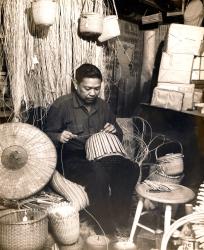
 |
Tuck't In: A Walking Tour of Historic Prospect Hill Cemetery Nan |

|
|
 |
José Formosa Reyes, by Louis S. Davidson, Courtesy of the Nantucket Historical Association |
Lot 1173
José Formosa Reyes. September 15, 1902 – December 24, 1980.
José was born in Ilocos Sur, Santa Maria, Philippines, the son of Eugenio and Maria Reyes. Educated as a child in his small village, he then attended Washington High School in Portland, OR. José went on to Reed College, where he met his future wife, Elizabeth "Betty" Ham. José received a master’s degree in education from Harvard. José and Betty traveled to the Philippines, where José taught art and English at the University of the Philippines. He next taught at the Philippine Military Academy, where he became head of the language department. José and Betty had three children: Francina (b. 1934), Paul (b. 1938), and Robin (b. 1941).In 1941, José joined the United States Army and was appointed Secretary to the General Staff. In 1945, after the Philippine Liberation, José and his family moved to the United States, and, in 1947, he became a United States citizen. José and his family arrived on Nantucket to visit his mother-in-law, Adeline Ham of Cambridge, Massachusetts. He fell in love with the island and decided to live on Nantucket. At first José tried to find a teaching position at Nantucket High School, and when that did not work out he became a house painter. He knew how to weave and learned the craft of lightship basket making from Clinton "Mitchy" Mitchell Ray (lot 11 Mount Vernon). José introduced a new form of basket, a covered ladies handbag called a "friendship" basket. In 1948, he produced his first handbags and displayed them on a stand in front of his house on York Street. In The Friendship Baskets and Their Maker, author Paul F. Whitten (see lot 1097) describes José’s shop:
The walls are covered with split bamboo. Great bundles of split cane for his baskets are hanging on wall pegs, on the backs of chairs, and strewn across his workbench. The floor is covered with the shavings from the wooden cover plaques and white oak handles. On the floor is a tub of water where Jose soaks his handles to make them pliable. There is a small display case with several finished baskets, waiting for the customers who ordered them. Other handbags and baskets are hanging from the ceiling.
The master-basket-maker sits in a corner on a cushion-covered stool, by a window, and plays away at the ancient art of weaving. Each stroke of his deft fingers accounts for a carefully woven strand of cane. There are no flaws in José’s handiwork. There is very little space for his customers in the crowded shop. His visitors appear to love the informality of the place. José’s baskets were built around a form of the original lightship baskets. Mitchy Ray had given some of his old forms to José. In Nantucket Only Yesterday: An Island View of the Twentieth Century, Robert F. Mooney tells how the basket lids began to be adorned with ivory:
One day, Muriel Sayle looked at her Reyes basket with its blank top and asked her husband, Charlie Sayle, to carve a sperm whale to decorate the basket, where it looked right at home. Soon everyone wanted a whale or another piece of scrimshaw on her basket.
Nantucket scrimshaw artists Charlie Sayle, Aletha Macy, and Nancy Chase created the ivory pieces that adorned the Reyes lightship baskets. Queen Elizabeth II received one of José’s baskets on the occasion of her coronation. In 2001, his son, Paul Reyes, donated his father’s shop to the Lightship Basket Museum.
Whitten included the prices for a Reyes basket at the time they were crafted: A large oval basket sold for $50, a medium for $45, and a small for $35. Many years later, one of the baskets was listed in the Rafael E. Osona auction of December 2004 as a "José Formosa Reyes Nantucket Round Friendship Basket with ebony carved whale, peg and knobs, signed upon base Made in Nantucket, José Formosa Reyes, 1959."
Author Peter Benchley (lot 1146) included José and his basket making in his 1970 article "Life’s Tempo On Nantucket" for National Geographic.
A Filipino immigrant, José Formosa Reyes, began to make the baskets 20 years ago and has become so successful that he welcomes competition. He works 12 hours a day in his tiny rose-covered shop. A sign on the counter proclaims, "No repairs until next year."
"Sometimes it takes two or three days to make a basket," he told me. "My backlog ranges between four and seven years. From the day I started it’s been like this."
José was a Rotarian, Mason, member of the Men’s Club, and an attendee of the Old North Church, where he sang in the choir. José’s baskets were known throughout the world. The New York Times of December 25, 1980, published his obituary: "José Formosa Reyes, Creator of Nantucket Pocketbook, Dies": His cane baskets, known throughout the world for their high price and durability, have become both a status symbol and a souvenir of the old whaling port.
Nantuckt Historical Association YouTube Jose Reyes on Lightship Baskets, with Dror Kahn.
Excerpt Tuck’t In: A Walking Tour of Historic Prospect Hill Cemetery Nantucket, Massachusetts by Paula Lundy Levy with YouTube video courtesy of the Nantucket Historical Association on YouTube.
© Copyright 2012 Prospect Hill Cemetery Association. All rights reserved
